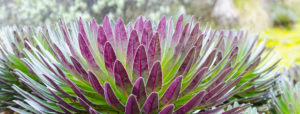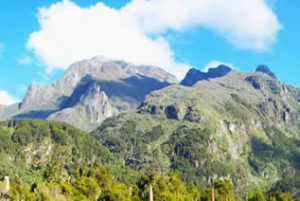 Rwenzori Mountains national park is Uganda’s most alluring hiking destination, located in the West of the country running along the Congolese border for 120km South of Lake Albert and North of Lake Edward. The national park was gazetted in 1991 with 996 sq. km protecting the upper slopes and glacial peaks of the 5,109m high mountain range. Two hiking trail circuits one starting at Kilembe in the South and the other at Nyakalengija Northwards about 20km lead you to the top of the mountain. A traveler can, therefore, take any one of the two trails to reach the mountain summit. Rwenzori hikes stick below the snowline at around (4,500m)
Rwenzori Mountains national park is Uganda’s most alluring hiking destination, located in the West of the country running along the Congolese border for 120km South of Lake Albert and North of Lake Edward. The national park was gazetted in 1991 with 996 sq. km protecting the upper slopes and glacial peaks of the 5,109m high mountain range. Two hiking trail circuits one starting at Kilembe in the South and the other at Nyakalengija Northwards about 20km lead you to the top of the mountain. A traveler can, therefore, take any one of the two trails to reach the mountain summit. Rwenzori hikes stick below the snowline at around (4,500m)  reducing the risk of altitude-related illnesses, however, experienced technical climbers can access the glacier peaks. Other days or short overnight hikes are also available at the other end of the commitment scale through the forested slopes above Kilembe or Nyakalengija or the Northern Rwenzori mini-hike between nearby Kazingo and Bundibugyo. This is especially for those with limited time, money or stamina. The mountains have a fascinating succession of attitudinally-defined vegetation zones, ranging from montane rain forests to Afro-alpine moorland, which forms a breathtaking scenery.
reducing the risk of altitude-related illnesses, however, experienced technical climbers can access the glacier peaks. Other days or short overnight hikes are also available at the other end of the commitment scale through the forested slopes above Kilembe or Nyakalengija or the Northern Rwenzori mini-hike between nearby Kazingo and Bundibugyo. This is especially for those with limited time, money or stamina. The mountains have a fascinating succession of attitudinally-defined vegetation zones, ranging from montane rain forests to Afro-alpine moorland, which forms a breathtaking scenery.
Rwenzori is roughly 120km long and 65km wide with six main massifs, the tallest being mount Stanley with two loftiest peaks; Margherita (5,109m) which is exceeded in altitude by only the freestanding volcanic cones of Kilimanjaro and Mount Kenya in the whole of Africa. This implies that Rwenzori is the highest proper mountain range on the African continent. The other peak of Mount Stanley is Alexandra (5,083m). The other four glacial peaks include Speke (4,890m), Emin (4,791m), Gessi (4,715m) and Luigi da Savoia (4,627m). In terms of Flora and Fauna, the vegetation of Rwenzori is divided into several altitude zones each with its own unique microclimate and wildlife species. The Afro-montane forest zone with the most varied fauna is found at the start at 1,800m. closed canopy forest starts to give way to dense bamboo stands at above 2,500m. Between 3,000m to 4,500m you find the open vegetation of the heather and Alpine zones with forests of giant heather trees throughout, the giant groundsel and the striking 10m high lobelia are also found in this region.
The Park’s diverse fauna includes over 70 mammal and 177 bird species. Most of these bird species are found in the Albertine Rift. Rwenzori Mountains National Park is the only Park in Uganda where the Angola colobus has been recorded through the identification this localized monkey requires a careful search and should not be mistaken to be the similar and more widespread black-and-white colobus that is also present on the mountain. Other mammal species include; elephant, buffalo, golden cat, servaline genet, chimpanzee, the blue monkey, yellow-backed duiker, and the giant forest hog.
Bird species in the forest zone of the park include; Rwenzori turaco, barrel-long-tailed cuckoo, long-eared owl, handsome francolin, cinnamon-chested bee-eater, archer’s ground robin, white-stared forest robin, Rwenzori batis, montane sooty boubou, Largen’s bush shrike, slender-billed starling, blue-headed sun bird, golden-winged sunbird, strange weaver, varieties of barbet, greenbul, apalis, illadopsis, flycatcher and crimson wing. Lammergeyer (bearded vulture) and black eagle soaring overhead as well as alpine and scarce swifts and the stunning scarlet-tufted malachite sunbird can be found at higher altitudes. We provide all the necessary transportation needs to make you reach Rwenzori region comfortably through car rental services.
Activities and attractions in the national park
Mountain Climbing
Mountain climbing is the key activity in Rwenzori mountain national park. Two hiking trails that lead travelers to the summit of the mountain are:
The Central Circuit Trail:
This starts from the trailhead at Mihunga providing a circular seven-day challenging climb tour of the high Rwenzori. From Mihunga, the route slopes past Nyabitaba along the Bujuku valley and then heads to the peaks. Along the slopes, climbers can view the snow peaks of the mountains.
Kilembe Trail
This ascends the Southern slopes of Rwenzori from the trailhead at Kilembe near Kasese town. This route takes you past glacial lakes along the Nyamwamba valley and then it joins the Central Circuit at Lake Kitandara.
Nature Walks
Nature walks to Lake Muhooma and through Buraro chimp forest, walks to the Karangura ridge through the communities of Kichwamba as well as hiking to Bundibugyo area through the Bwamba Pass.
Guided forest walks are also done through the communities of Ruhoni and Turaco view where can trail along River Mobuku. Continued hikes to above 2,300m allow you to see Baker and Portal peaks and on a clear day, it is even possible to view the eye-catching snow capped Margherita peak. Amazing species like the chameleon, squirrels, Vervet monkeys and various birds.
Birding
The Rwenzori national park has got an exciting view of unlimited bird species that have chosen this inhospitable environment as their home. These include among others bee-eaters, robins, sunbirds and barbets, the Rwenzori Turaco, long-eared owl. Higher hikers can also view the bearded vulture, swifts and black eagles.
Cultural Encounters
The cultural trail with the Mihunga community tourism group and Turaco view takes you for a village cultural tour where you encounter a traditional healer’s demonstration, a village school, crafts displays and finally be entertained with a lively traditional dance performance. You can’t afford to miss the encounter with the rich culture of the Bakonzo during the Bulemba-Ihandiro Cultural Trail. While on this trail, an experienced local guide introduces you to the traditional healer locally known as “Muhima”, and to a local blacksmith. The residents also introduce you to their basket weaving and fire making skills. The final part of the trail takes you across the Kamusonge River whose water the locals treasure so much because it is believed to b so sweet and quickly quenches thirst. Finally, a visit to the traditional thatched Konzo style museum displays the implements used during the Rwenzururu struggle as well as other items of historical and cultural importance to the Rwenzururu tribe including traditional dresses, handicrafts and many more.
How to get there
There are two main routes from Kampala to Rwenzori Mountains National Park. The shorter route leads you to the Park Trailhead at Ruboni from the North via Fort Portal with 375km. the second route is from the South passing through Mbarara and Queen Elizabeth National Park with 450km from Kampala.
By air, there are charter flights to Kasese that can be arranged from Kajjansi Airfield and Entebbe International Airport.
Accommodation
For budget visitors, Kasese has a more decent selection of accommodation at the lower end of the price scale. For more upmarket accommodation, you are better off in Queen Elizabeth National Park, Fort Portal or Nyakalengija where you can find more furnished hotels and lodges.
What to wear
It is very essential visiting Rwenzori when you are properly prepared since wet conditions and sub-zero temperatures are normal in the park. Travelers should have a proper packing list of all the requirements in the hiking session. These include:
Layered warm clothing for the nights
A decent waterproof jacket and trousers since rain is expected at all times of the year even during drier months. Plenty of plastic bags to keep both the dry clean clothes and wet or dirty garments. Hiking boots for some parts that are incredibly muddy and you will be better of wearing locally bought gumboots elsewhere above the forest and bamboo zone.
Pack a few snacks, chocolate and the like to keep you going on your distant likes. Climbing boots and equipment such as ropes, ice-axes, harnesses, crampons and walking sticks for those who intend to climb one of the glacial peaks.
Snow goggles, a compass, and altimeter are also useful.
You may also need to bring or hire a camping stove if you opt for self-cooking.
Health Tips
Mountain climbers should be reasonably fit and without heart or lung problems.
Hikers may not feel hungry once above 3,000m but they should try to eat.
Carbohydrates and fruits are recommended whereas rich or fatty feet are discouraged since they are harder to digest.
Take at least three litters of water daily since dehydration is one of the major reasons for failure to complete the climb. Water loss through sweating can also be minimized by taking off some layers of clothes before starting to sweat.
Mountain climbers are highly advised to allow themselves time to acclimatize by taking an extra day over the ascent, eating and drinking properly and trying not to push themselves. This helps to reduce the risk of altitude-related illnesses especially for those who go above 3,500m. These are associated with minor symptoms such as headaches, nausea, fatigue, breathlessness, sleeplessness, and swelling of the hands and feet.
That said, Rwenzori Mountains National Park is a very unique tourist destination in Uganda as it offers its visitors extra and exciting attractions that cannot be found in any other Uganda national park. In addition to game viewing, bird watching, nature walks, and hikes, primate tours and cultural encounters, the park offers a rare mountain climbing experience to its beautiful glacial peaks that can only be rivaled by the Alpine mountains of Europe. Therefore, a visit to this high altitude place leaves you with a full package of experience of all Uganda’s tourist attractions with nothing else to admire.
